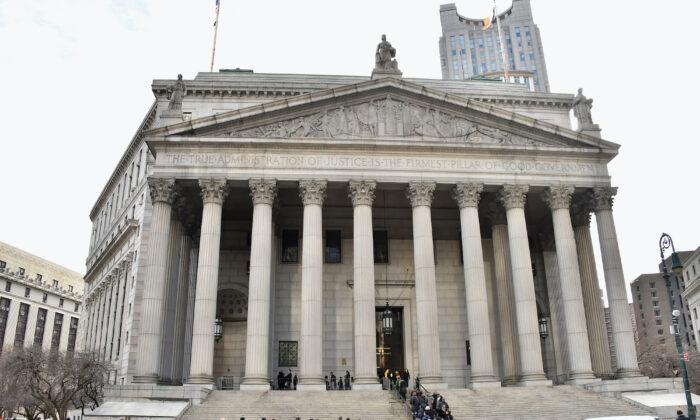A new statue that has been placed on top of a Manhattan courthouse is sparking controversy among New Yorkers as well as a former White House adviser.
The
statue was made by Pakistani-American artist Shahzia Sikander, 53, and has been erected on the roof of the courthouse of the Appellate Division, First Judicial Department of the State Supreme Court, alongside statues of a string of other famous lawgivers.
It is
reportedly the first female figure to be placed on top of the court building.
Co-commissioned with the
Public Art University of Houston System, the eight-foot gold nude figure features a lace collar, giant horns, and tentacles for arms and feet.
Twitter Users Say Statue Is ‘Demonic’
Some Twitter users have
branded the statue “demonic” and an “aesthetic atrocity.”
Former White House adviser Stephen Miller, meanwhile,
called the statue a “visual desecration of the landscape” on Twitter.
International best-selling author and Edgar Award Winner, Andrew Klavan also commented on the statue,
posting on Twitter: “The New York Courthouse has added this aesthetic atrocity to its sculptures of great lawmakers. It is meant to honor Ruth Bader Ginsburg’s pro-abortion stance by depicting a woman with demonic goat horns who has clearly lost the power to reproduce. Or something.”
Ginsburg
died at the age of 87 in September 2020 due to complications from metastatic pancreatic cancer. She served 27 years on the Supreme Court.
Elsewhere, former Breitbart editor and political podcast host Ben Shapiro
posted on Twitter: “If you gaze upon RBG Medusa atop the New York Courthouse, your uterus turns to stone.”
Speaking to the
New York Times, Sikander said the statue is called “NOW” because “it was needed now, at a time when women’s reproductive rights were under siege” following the U.S. Supreme Court’s decision to overturn Roe v Wade.
Abortion is legal in New York. Earlier in January, Mayor Eric Adams, a Democrat,
announced that four city-run sexual health clinics will begin offering free abortion pills, funded as part of a $1.2 million package for sexual health services.
More Artwork to Come in Courts Across the Nation
In her artist
statement regarding the piece, Sikander explained that “the image of justice as a woman has been present for centuries, but women only gained juridical voice in the last one.
“Despite years of women’s struggle for legal socio-economic and political equality, gender bias still continues to create barriers for many women, whether it is health and education rights, equal economic opportunities, gender-based violence, and race or class discrimination.”
Meanwhile, Justice Dianne T. Renwick, chair of the Court of the Appellate Division committee, which is leading an effort to add new diverse art pieces to the courthouse, said in a statement to TimeOut magazine: “Throughout history, we have been champions for freedom, equal rights, and justice.”
“For the first time since the Court’s historic opening well over 100 years ago, the figure of a woman finally and rightfully will stand on equal footing with the male philosophers and lawgivers who line the other pedestals,” Renwick said. “This type of collaboration is unprecedented in New York,” she said, adding that she was excited about the possibility of various other pieces of artwork going up in other courts across the country.
A similar statue, titled “Witness” which is adorned with a giant hoop skirt, currently sits in Madison Square Park in Manhattan. Both statues will be on display until June.
The statue is part of Sikander’s exhibition in New York titled “Havah...to breathe, air, life.” Havah means “air” or “atmosphere” in Urdu, according to Madison Square Park’s official
website.
It also means “Eve” in Arabic, Hebrew, and Turkish.





